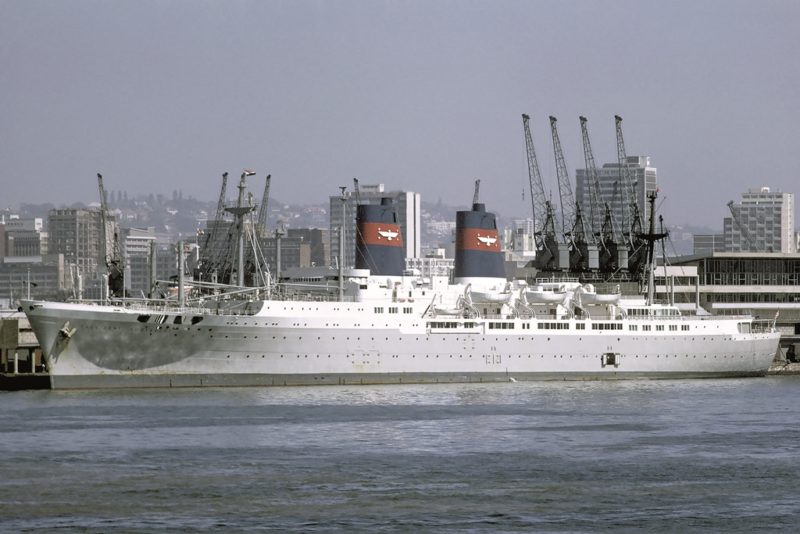
Imagine for a moment that ships were human, congregating at the pub to talk through their memories and careers. I think it’s fair to say that amidst all the banter, camaraderie and exaggerated hyperbole, one ship could justifiably lay claim to the ’been there, done that, got the T-shirt’ award for having one of the longest, most diverse and arguably fulfilling ‘lives’ of them all. Over more than six decades, under eleven names, enduring more than its fair share of cosmetic surgery, this was a born survivor. From Second World War troopship to transatlantic transport, Hawaiian tourist ship to luxury trans-Pacific liner, Caribbean ‘booze’ cruiser to (finally) around the world voyager, this was a vessel that went everywhere and did everything. General W. P. Richardson was a truly remarkable, memorable ship.
She was originally allocated the name General R. M. Blatchford in April 1944, as yard number 276 at the Federal Shipbuilding & Drydock shipyard, Kearny, New Jersey. Established in 1917 to supply new tonnage to the United States Shipping Board following the nation’s entry into World War I, by 1943 the yard employed 52,000 people and proudly claimed to produce ships quicker than any other shipbuilding facility on earth. The new ship was to be the ninth of eleven P2-S2-R2 type combination troop and freight vessels (also known as the General John Pope class, after the lead ship) ordered for and subsequently assigned to the US Navy by the US Maritime Commission. At 17,811grt, the 622 foot long, 76 foot beam design provided basic accommodation for a total of 5,200 troops along with 144,000 cubic feet of hold space for their equipment, vehicles and ammunition.
For safety the design’s hull was devoid of portholes, so ventilation was provided by a comprehensive air-conditioning system instead. Indeed these were amongst the first vessels to be fully air-conditioned throughout. Further military design elements were to be found in the belly of the ships, where a pair of autonomous engine rooms contained the two sets of De Laval geared turbines (consisting a high-pressure and low-pressure unit with the astern machinery attached to the latter), generating 18,700shp. Harnessed to twin propellers the turbines propelled the ships at approximately 20 knots. For protection they were initially fitted with four 5inch calibre guns and four 1.1inch quad anti-aircraft guns.
Sponsored by Mrs Brebon B. Somervell, the first keel plates of the new ship were laid on 2nd February 1944, and illustrating the remarkable ’production line’ efficiencies instigated by the US Maritime Commission, under the watchful eye of William Francis Gibbs, she was then launched into the Hackensack River on 6th August having been given the revised name General W. P. Richardson on 1st July 1944. By the end of October she was complete and on 2nd November, just nine months, or 274 days after the keel laying she was commissioned by the US Navy under pennant number AP 118. Incredibly the yard was turning out Type C-2 transports, from keel laying to commissioning in just 82 days, and even large destroyers in just 170.
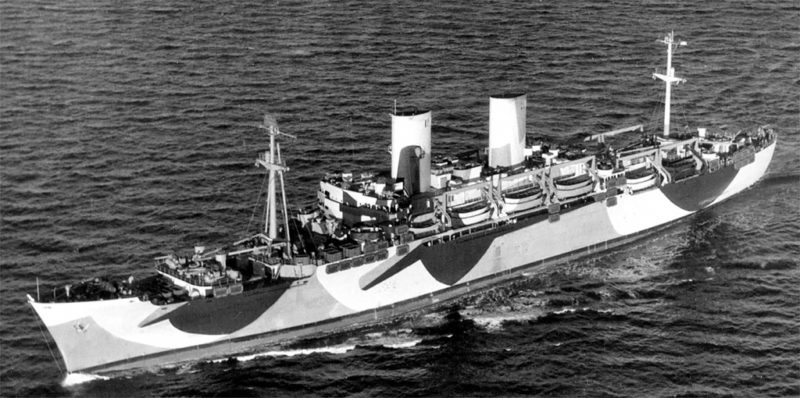
With their high freeboard, low superstructure and tall, closely spaced twin funnels, the P2-S2-R2 ships had a quite intimidating presence, accentuated by the sturdy, stunted fore and aft masts. Sporting a paint scheme of assorted curves and oblique angles, in a range of light to charcoal grey tones, General W. P. Richardson set off on her unheralded maiden voyage from Boston on 10th December 1944, packed with about 5,000 GIs and assorted military hardware, bound for Southampton and the European theatre. Having returned to New York with the wounded and those on rotation she set sail again on 14th January, to Naples with reinforcements for the Allied push up from Italy. For the rest of the war she shuttled back and forth across the Atlantic, mainly to Le Havre or Southampton. By April 1945 however the flow of troops was steadily reversed, with fewer outbound to Europe but an increasing stream of returnees. On 28th April 1945 she arrived back at New York, to reunite 2,900 wounded troops and 1,000 recently liberated American POW’s with their relieved and elated relatives. Ten days later came the German surrender and with it a flood of returning GIs, 4,200 landing at Boston from Southampton on 28th June 1945 alone. By August the war in the East had also come to its terrible conclusion and in October General W. P. Richardson was sent from Boston, via Suez out to Karachi, returning to New York just two days after Thanksgiving, on Saturday 24th November 1945 with 5,000 American veterans. Following a further trip to first Italy and then Iran, the hard working troopship finished official military service on her return to New York on 23rd January 1946.
Having been decommissioned, on 14th February 1946 she was transferred by the Maritime Commission to the US Army and sent to the Hoboken facility of Todd Shipyards for a two and a half month refit. Stripped of her troopship interiors she was provided with basic but less Spartan accommodation for troops and their dependents, returning refugees and where available, civilian passengers. It appears that portholes were cut into the hull at this time, thereby creating outside cabins along the outer shell. She was assigned to a Mediterranean service where there was a dearth of available commercial tonnage. The Italian Line fleet which had previously dominated the Mare Nostrum was now scattered and sunk along it’s coastline or still serving the allied cause, and American shipping lines were yet to recover and re-establish their services from the lengthy shadows of war.
Having completed these austerity sailings and been laid up on 10th March 1948 General W. P. Richardson was then chartered to American Export Lines for their Mediterranean service. She was an ideal candidate for re-establishing the company’s service whilst it awaited the delivery of its two new flagships that would emerge as Independence and Constitution at the turn of the decade. In fact General W. P. Richardson was regarded as something of a test case, a prototype to see whether erstwhile troopships of this design could make the transition to commercial service. She was sent to the Ingalls shipyard at Pascagoula, Mississippi for a $5million refurbishment to make her fit for purpose. The ship was fitted out with accommodation and public rooms for 157 First Class and 452 Tourist Class passengers. She emerged in May 1949 with American Export’s unmistakable funnel livery, black with a broad central white band sandwiched between two slim red ones and adorned with a large black E, and sporting a new name on her smart black hull, Laguardia, after New York’s long serving, beloved mayor, who had died a couple of years before.
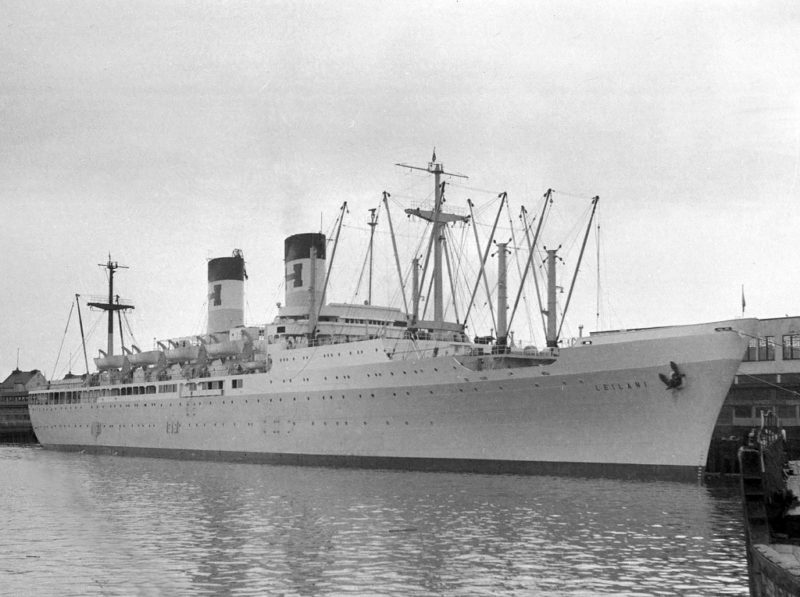
Laguardia departed New York on 27th May 1949 on her maiden voyage to Genoa and Naples. In due course her itinerary was amended and extended, so the revised timetable featured calls at Gibraltar and Palermo before docking at Naples. She would then sail on to Piraeus before reaching her eastern terminus at Haifa in Israel. Perhaps it was the temporary nature of the arrangement, or perhaps due to comparison with the recently commissioned Independence and Constitution but the charter wasn’t renewed when the original agreement expired at the end of November 1951. Quite simply American Export Lines found the ship too expensive to operate. Her powerful turbines, deep draught and heavy military construction meant she was an extremely sturdy sea boat but also costly. It was an Achilles heel that would scupper the career of many other ships and indeed the experiment wasn’t repeated with any of her ten sisters (the General Gordon was partially refurbished but never sailed commercially). Nevertheless Laguardia was nothing if not resilient. Having been briefly laid up she was then chartered by the Military Sea Transportation Service and utilised by the US Army for diverse trooping duties, to Southampton and Bremerhaven to bolster US forces against the growing Soviet threat in Europe and to South East Asia with reinforcements for the UN ’policing’ action known universally as the Korean War. Interestingly although she retained the same name and hull colour, her funnel livery changed according to the location. So on the Atlantic she bore the red, white and blue of United States Lines and on the Pacific American President Line’s blue with a red band containing a stylised white eagle emblem.
One year later and with her trooping activities complete Laguardia was returned to the United States Department of Transport-ation’s Maritime Administration (given the confusing acronym MARAD) and designated part of the National Defence Reserve Fleet. Consisting at the time of mainly WWII vintage freighters and troopships, the Reserve Fleet’s purpose was to provide a source of mothballed vessels capable of being reactivated within one to three months in order to help in the event of a national emergency or military conflict. In November 1952 Laguardia joined other reserve tonnage in the James River, Virginia. Most ‘internees’ of the James River Reserve Fleet would go on to sit idly rusting away for decades until finally called to the scrap yard, but once again Laguardia proved to be an exception. In 1954 the Seattle based Hawaiian Steamship Company started to look into the viability of converting Laguardia to their requirements for service between San Francisco and Honolulu. Two years later their plans developed further when Hawaiian Textron a subsidiary of New York’s Textron Inc. acquired the ship. Laguardia was moved from the James River to the New York Shipbuilding Yard at Camden New Jersey, for a $4 million refit to transform her into a one-class tourist liner for 650 passengers.
Sporting crisp, modern American style interiors and a vibrant green hull (which matched the lower half of those towering funnels), she certainly looked unique and tropical. The completed ship was renamed Leilani (Hawaiian for ’Heavenly Flower’) and chartered to Hawaiian Steamship. The maiden sailing was scheduled for January 1957, effectively consisting of a positioning voyage from New York to California, via Panama. It proved to be a nightmare baptism for the ship and a traumatic trip for those first passengers. Widespread flooding and plumbing problems, compounded by an outbreak of food poisoning drew unfavourable press reports and plenty of adverse publicity. Like American Export the new operators were also shocked at the ship’s high running costs, particularly fuel consumption on her San Francisco-Honolulu-Hilo-Los Angeles-Honolulu-Hilo-San Francisco cycle of voyages. Competing with the well-established Matson liners Leilani predictably struggled and two years later, on 29th December 1959, she was laid up in San Francisco when the company folded. For five months she sat idle until the Maritime Administration, who as the principle creditors seized the ship on 12th May 1959 offered her for sale.
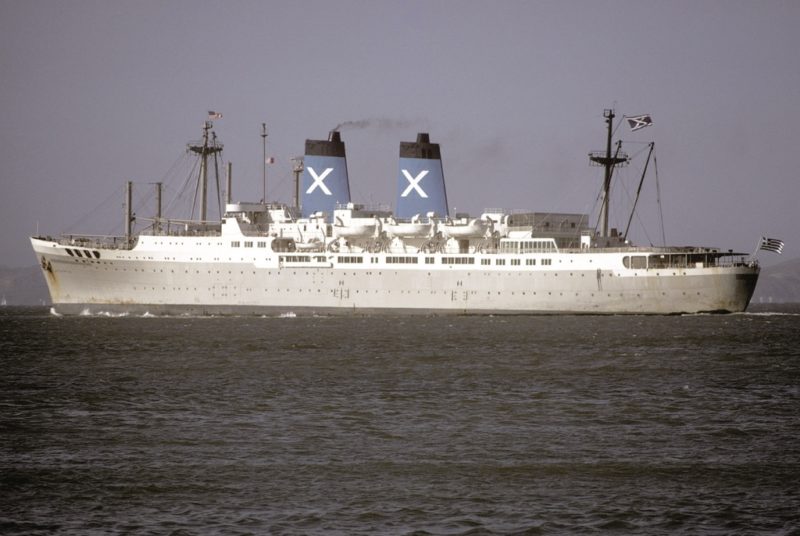
It would be almost two years before Leilani’s engines were fired up again. Once more she was acquired for service in the Pacific but this time on a different, extended route and for a very different clientele. On 25th July 1960 she was purchased by American President Line (APL) for their luxury trans-Pacific service, to complement the incumbent liners President Cleveland and President Wilson, which were of near identical size and speed. In fact both these vessels had originally been laid down as P2 troopships in 1944 but the order had been cancelled and they were subsequently redesigned and completed as commercial ships. To bring the new acquisition up to the standard of the existing liners and the expectations of their very discerning passengers, APL clearly spent a considerable time developing the design before she was taken to the Puget Sound Bridge and Drydock Company, Seattle, for a $10 million rebuild and transformation.
Work eventually commenced on 1st March 1961 and it was not until the following May that she made her debut, having been delivered on 16th April 1962, steaming out of San Francisco for Los Angeles, Honolulu, Yokohama, Kobe, Hong Kong and Manila. The complete round trip took forty two days.
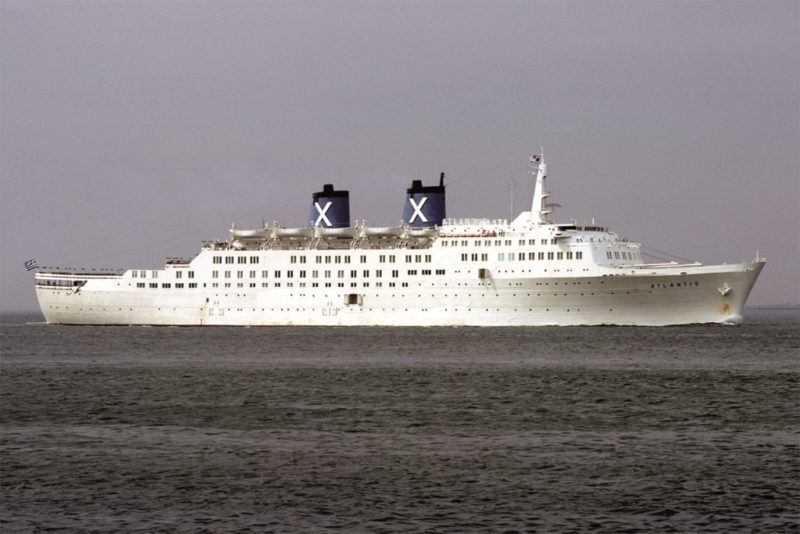
Those first passengers embarking at San Francisco on 11th May 1962 were entering a vessel that was unrecognisable from her previous incarnations. To begin with there were only a maximum of 456 onboard, barely two-thirds of Leilani’s complement. Unlike Presidents Cleveland and Wilson which offered both First and Economy class accommodation the company’s new acquisition would be all First Class. The interiors were the work of designers Anshen and Allen whose ‘Country Club relaxation’ decorative theme was perhaps best personified in the Pacific Lounge on Promenade Deck which formed the central meeting hub of the ship. On the rear facing bulkhead of this room was a large oil mural depicting sailing ships and boats from across the ocean bracketed by iconic landmarks, a Japanese Tori gate and the Golden Gate Bridge. Aft of the Pacific Lounge was a Cocktail Lounge and then the more subdued and traditional feel of the Roosevelt Room, complete with wood paneling and table lamps, wholly appropriate for its role as the ship’s library and ‘quiet’ room. The ship had a definite adult feel to it, nevertheless for teenagers, forward of the Pacific Lounge was the specially sound-proofed Club Room complete with record player and Coke dispenser, whilst a children’s play room and adjacent outside deck area was provided right at the stern. One deck up, the fully glazed Starlight Room opened onto the Lido Terrace and swimming pool and was a veranda bar by day and a wonderful venue for cocktails and after dinner dancing by night. Illuminating the room was a huge mosaic mural depicting a stylised portrayal of the constellation ’Orion’ by Irene Lagorio. The Presidential Dining Room on Main Deck decorated in Rose and Grey tones was a luxurious venue for enjoying ‘Sole au vin blanc’ or ‘Roast Baron of Beef’. President Roosevelt was advertised as a multi-million dollar American resort hotel with the bonus that ’’you can take it with you to the Orient and back’. In her décor and appointments she could justifiably be considered amongst the finest passenger ships afloat.
Movie stars and millionaires mixed with captains of industry, senior military personnel and wealthy tourists to be indulged and pampered on board the the new APL liner. In sharp contrast to Leilani which never recovered from her ill-fated maiden voyage, President Roosevelt’s excellent reputation was secured from the very start. The jets took rather longer than their trans-Atlantic equivalents to conquer the Pacific but ultimately the relative convenience and timesaving of air travel won the day. As the 1960s progressed President Roosevelt was spending more and more time cruising. There was no need for further modifications and she continued to attract a full complement of passengers, whether on three day trips down the California coast or 95 night circumnavigations of the globe. Concentrating mainly on Pacific itineraries she was now seen from Alaska to Acapulco and inevitably on round trip cruises to Hawaii. Nevertheless her high operating costs once again began to hurt and by the end of the decade President Roosevelt was operating in the red.
At the beginning of 1970 the ship was offered for sale and quickly snapped up for $1.8 million by Anthony Chandris. Ownership was transferred through a subsidiary company Solon Navegacion SA, although she was to be operated by his namesake shipping line. To the dismay of her loyal but dwindling following President Roosevelt arrived in San Francisco for the last time on 22nd March and was handed over to Chandris on 10th April 1970. With her funnels freshly repainted in blue with Chandris’ broad white Xs, her former name painted out and the Greek flag proudly fluttering from her stern she left San Francisco. She steamed half way around the globe to Chandris’ own Ambelaki shipyard at Perama, for the most substantial reconstruction of her long and eventful career. Chandris were able to minimise costs by undertaking much of the work ‘in house’ but even so the $8.5 million refit represented a substantial investment in a 26 year old ship.
All the redundant cargo handling machinery, masts and hatches were removed and the superstructure extended significantly, both fore and aft. At the stern this created one of the most expansive Lido areas afloat, accommodating a large, irregular shaped, heated swimming pool. With the exception of a small lounge and café opening up onto the Lido and the Dining Room below, all of the main public rooms were now centred on Rainbow deck. The void left by the previous array of lounges and cargo space was filled with 261 new cabins, more than doubling the passenger complement to 1,092.

Although the company were primarily associated with their emigrant passenger service from Europe to Australia, Chandris were seeking to expand their presence in the expanding North American cruise market. Early plans indicated that her cruising capacity would be restricted to 756 occupying only lower berths with the higher figure applying to Australian emigrant service when Pullman style upper berths would be utilised. In practise she never sailed on the Antipodean run, Chandris having decided at the outset to position her out of New York for cruises to the Bahamas. As would be expected in this era every cabin included its own toilet and shower facilities. For a premium passengers could book one of seventy lanai suites, hangovers from her President Roosevelt days which included a separate sitting room area. She sailed to Rotterdam for completion of the final elements of the refit and thence directly to New York without passengers, receiving a traditional tug and fireboat spray reception when she arrived on 29th June 1971. Three days later she sailed to Freeport and Nassau on a maiden seven day cruise.
Atlantis proved to be a rare error of judgement by Anthony Chandris. Despite the considerable investment in her rebuild, the thirsty turbine machinery was retained and merely overhauled. It needed to run at almost full power simply to maintain the punishing weekly schedule, consuming oil at an alarming rate. Despite her ‘new’ look and facilities it was perhaps over-optimistic to expect Atlantis to adequately compete with Home Line’s larger, faster Oceanic, already established as the finest year-round cruise ship afloat and plying the same New York to Nassau schedule. Load factors for that first summer season averaged just 70%. Worse was to come.
For the ensuing winter cruise season Atlantis moved to Florida and a series of ex-Port Everglades cruises deep into the Caribbean. Once again she was up against a broad spectrum of competitors, from repositioned grand liners like France and the new QE2 to established conversions like Flavia. There were also new cruise lines like NCL and Royal Caribbean with efficient, bespoke tonnage. In her first five Caribbean voyages from Port Everglades passengers filled just 16% of available berths, the season as a whole could only be seen as disastrous. By the end of the year, just six months after that triumphant maiden arrival in New York, Atlantis was put up for sale. Barely a month later, on 31st January 1972 came the announcement that Atlantis had been sold to Eastern Steamship Lines Inc. for a total of $13 million. In part payment of the deal Atlantis’s predecessor at Eastern Cruises, the considerably smaller Ariadne, was transferred to Chandris. Under the terms of the sale contract Atlantis would complete Chandris’ already advertised 1972 cruise schedules before being handed over to her new owners in October.
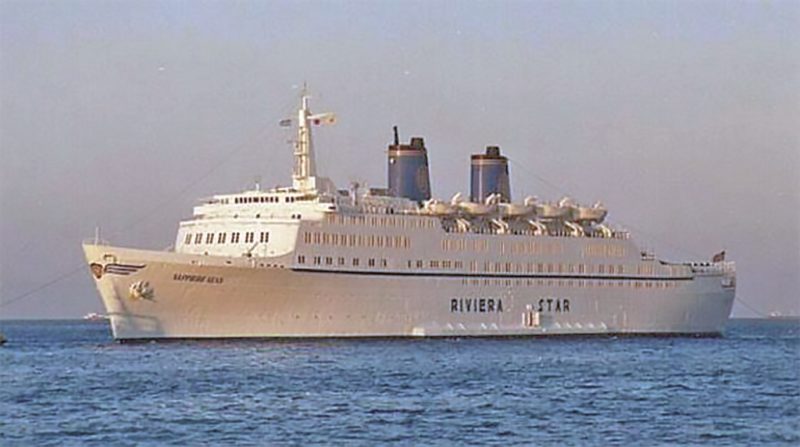
Puzzlement within the industry at Eastern’s investment in a clearly failing ship soon turned to admiration for their foresight. Under the guidance of F. Leslie Fraser who acquired the company and its ships in 1954 Eastern pioneered the short-sea cruise trade between Miami and the Bahamas, in partnership with the island authorities. Following an interim change in ownership the business was purchased by Gotaas-Larsen in 1970, a Norwegian company which operated a substantial tanker fleet but also had a stake in the recently formed Royal Caribbean Cruise Lines. With the tanker trade in recession Gotaas-Larsen decided to concentrate on expanding their cruise ship operation, since cruise passenger numbers through Miami had grown from 188,000 in 1967 to 610,000 in 1970 and it was predicted to expand exponentially over the following decade. They started searching for the requisite tonnage to supplement the vessels they had inherited and decided that Atlantis fitted the bill.
Eastern Cruises knew their new ship’s principal flaw, high fuel costs, but accurately predicted that the sedate service speed required for their three and four day cruises, coupled with long periods moored at Nassau, would mitigate the problem. On the positive side they were acquiring a virtually new cruise ship, which in terms of size and capacity precisely matched their requirements. Perhaps most importantly they could start to use her almost instantly once the company’s funnel livery had been applied. The interiors were initially left untouched.
Renamed Emerald Seas and registered in Panama she departed Miami for her maiden cruise on 8th December 1972 as the largest vessel in the ever growing fleet of the short-sea Bahamian cruise trade. Gotaas-Larsen clearly knew their market and Emerald Seas became an instant success. Departing Miami each Monday at 4.45pm she spent Tuesday to Thursday docked at Nassau before a 1pm departure back to the Florida port. In the course of Friday she picked up her next complement of passengers for another quarter to five departure, then from 9am Saturday to 4.45pm Sunday lay once more alongside the Nassau quay before another overnight trip back to Miami. Year in, year out, with just a few variances, additional calls at Freeport from the mid-1970s and Little Stirrup Cay, also named Coco Cay, one of the tiny Berry Island archipelago, from the mid-1980s, the cycle drew capacity shiploads of predominantly mid-West vacationers, flying in to embark on what was, for many, a first sea voyage.
With shipboard time so limited the focus was inevitably on passengers’ time in Nassau. Marketing literature encouraged them to ’Shop for duty-free imports. Sightsee, gambol on the beach. Catch the calypso beat in a native nightclub. Try your luck in a glittering casino and take in the excitement of a lavish show.’ It was an almost guaranteed formula for success and the island’s government actively encouraged the influx. For the next twenty years, witnessing merger and consolidation with associated changes of ownership and funnel livery, Emerald Seas maintained a similar schedule, providing popular and crucially profitable service.
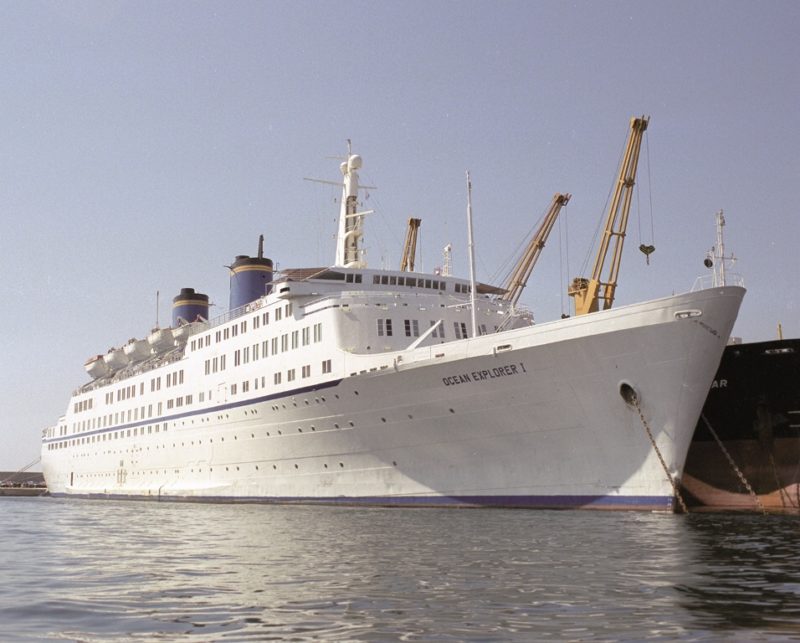
Overall those two decades passed relatively incident free, but on 31st July 1986 Emerald Seas’ passengers and crew experienced that most feared of maritime incidents, fire. She was anchored off Little Stirrup Cay when the blaze was initially discovered around 09.10am. It started close to where many of the 987 passengers were congregating on the lower deck tender embarkation points, in preparation for a day on the tropical island. Soon afterwards an explosion ripped through an adjacent engineer’s locker when the flames ignited a welding oxygen tank. The ensuing conflagration took over one and a half hours to bring under control, having spread from the locker to the ship’s laundry and crew galley. Passengers were called to lifeboat stations and ferried ashore as the Coast Guard mounted a full-scale rescue operation involving helicopters, cutters and aircraft. Although fifteen passengers and two crew members were airlifted to Miami and Nassau hospitals, the majority suffering from the effects of smoke inhalation, there were no fatalities and all bar two were discharged the following day.
In 1988 Admiral Cruises, which had emerged from the consolidation of Gotaas-Larsen’s ownership of Eastern Cruise Line, Western Cruise Line and Sundance Cruises, was acquired by Royal Caribbean Cruise Line, but initially Emerald Seas continued to operate as before. However in 1989 the new owners placed Emerald Seas on the sales list, initially attracting the attention of Hong Kong interests, presumably for a role as a gambling ship, but when that deal failed to materialise she returned to the three and four day trade. Nevertheless from May 1990 her role was taken over by Nordic Empress, a ship initially ordered by Admiral Cruises but subsequently completed for Royal Caribbean, so Emerald Seas was transferred to a similar itinerary sailing from Port Everglades. This proved wholly unsuccessful and so once again she was offered for sale in December 1991.
The forty seven year old ship now entered the most confusing episode of her long career, one in which her name changed four times in the space of twelve months, in which there were various rumours and reports of impending employment but she never actually left port.
Admiral cruises withdrew Emerald Seas from service on 20th February 1992 and she was sold to Selsdon Maritime Corporation of Liberia, which acquired the vessel on behalf of the Cypriot ship owner Takis Shiakilis. He intended to operate the ship under his Ambassador Cruises brand. Renamed first Fantastica, then Funtastica and finally Terrifica, she was due to recommence three and four day Bahamian cruises in October 1992 but instead remained laid-up at Port Everglades.
Amidst ongoing confusion and doubtless something of an identity crisis, in December 1992 the tethered ship became Sapphire Seas with proposals that she would start the Nassau service on 4th February 1993. The start date was later amended to early April but despite the various announcements and travel agent briefings she remained firmly attached to a Port Everglades pier through until January 1994, when the ocean-going tug Hispania sidled into port and secured a towline. Shiakilis’s new plan was to take the Sapphire Seas to Piraeus and refurbish her for Mediterranean cruise service.
She almost never made it. Having almost reached the Straits of Gibraltar she developed a leak and a perilous ten degree list. Hispania diverted to Cadiz, where repairs were effected to the veteran cruise ship’s bilges and ballast tanks and it appears sponsons were built on each beam before the tow recommenced. She arrived at Piraeus on 3rd February but there was no refit started and instead she joined a moribund line of anchored tonnage in Eleusis Bay.
In fact whilst she lay idle in the bay plans were coming to fruition. She was marketed by Cypriana Holidays and in mid-summer activity around the ship included emblazoning the name Riviera Star in large letters on her flanks, although she was never formally renamed. Under this assumed pseudonym she departed Piraeus on 9th July 1993 for a series of seven day Greek Islands cruises which also incorporated calls at Kusadasi (Turkey) and Haifa (Israel). She subsequently returned to lay-up in Eleusis Bay but in 1994 was reported to be found back in California for the first time since her President Roosevelt days, plying a series of short cruises to Ensenada in Mexico from San Diego. By the end of 1994 she had returned to Greek waters and a winter recuperation before embarking on a charter to Discovery Cruises planned for the following spring and then a further series of Eastern Mediterranean cruises in the summer of 1995.
Unfortunately Sapphire Seas now entered a phase in which she became the innocent collateral in a variety of financial and legal disputes. First she and fleet mate Romanza were arrested in Eleusis Bay at the behest of creditors to another Shiakilis owned company, Best Group, which collapsed at the start of 1995. The scholarship charter and Greek Island/Haifa cruises were therefore cancelled.
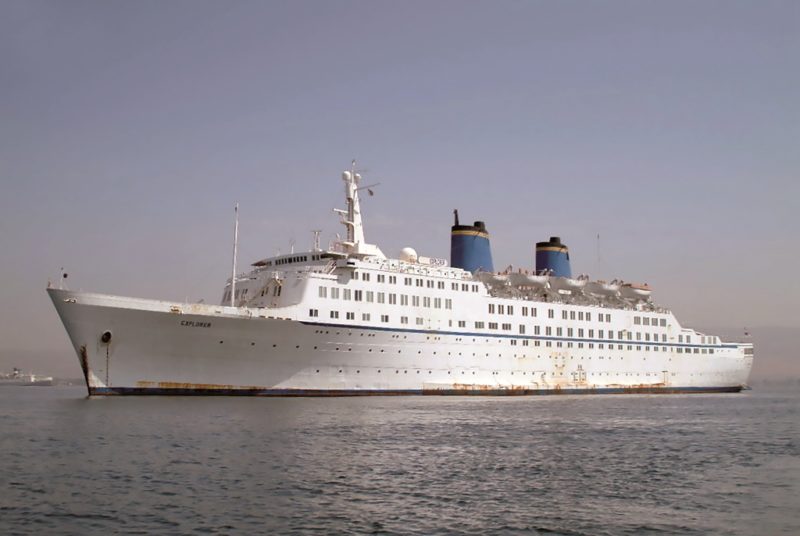
Reports of a sale to Arab interests proposing to use the ships for Red Sea cruises fell through and it wasn’t until the following June that she was sold to an unidentified Syrian-born Cypriot. Unfortunately her woes were not behind her. On 10th July she arrived off Limassol having reputedly received a refit at Piraeus prior to commencing a charter to Israeli based Caspi Shipping, but on the 12th was arrested (once more) by the Admiralty Court of Cyprus. Caspi had instigated the action on the basis that the owner had breached the terms of the charter by failing to supply the ship in the requisite condition. The court arranged an auction of the ship in October 1996 but there were no bidders and she remained anchored off the Cypriot capital until the following summer. She then returned (still under arrest) to Piraeus.
If it initially seemed that the beaches of Alang were finally calling she cheated the scrap yards once again. Sapphire Seas was acquired by a consortium of Greek banks. With ownership listed under Excellence Holdings SA, she was renamed Ocean Explorer 1 and placed in the management of Majestic Cruises. Following a $4.5 million refit she sailed to Lisbon in May 1998 for a four month charter as a hotel ship, moored along the Tagus River for the city’s Expo’ 98 exhibition. On her return to Piraeus she was given a further, more significant refit, in preparation for a return to active service under charter to Marine Expeditions. This interesting Canadian organisation operated as World Cruise Line and as the name suggests proposed using Ocean Explorer 1 for their initial advertised programme of three around the world voyages. Marketed as ‘The Last Frontier’ the company’s ambitious schedule of 35 ports in 127 days visited six continents, (ironically perhaps North America was the only exclusion) with passengers going ashore on Antarctica utilising zodiac RIBs. From Darwin to Mombasa, Singapore to Santiago, Rio de Janeiro to Easter Island it was a fitting farewell global tour. She looked as good as ever but unfortunately she was the wrong ship for the service, once again the aging, thirsty turbines proving to be her downfall. The high fuel consumption and corresponding operational costs were crippling for Marine Expeditions and when she arrived back in Piraeus on 25th March 2000 the departure of the next cruise, scheduled for the following day, had already been postponed. World Cruise Line advised prospective passengers and the media that the delay was due to plumbing and ventilation problems on board but it was almost certainly prompted by having sold only 48% of the 770 available berths. Under dispute the charter was terminated and the ship returned to her owners and lay up in Eleusis Bay. World Cruise Line subsequently chartered a smaller replacement vessel named Crown del Mar, but on 26th May the company folded after that ship was arrested at Papeete, in respect of her predecessor’s unpaid bunkering bill. The Greek owners of Ocean Explorer 1 were now unable to secure recompense for the early termination of the charter. Indeed they found themselves on the receiving end of a $2 million counterclaim from the Canadians regarding Ocean Explorer 1’s alleged substandard condition at the time the charter commenced.
Other than a brief charter as one of thirteen accommodation ships for the G8 summit held at Genoa in July 2001 Ocean Explorer 1 remained laid up in Eleusis Bay for the next four years. Discussions regarding an impending sale to the South African Wellness International organisation in 2002 for conversion into a timeshare ship failed to develop and subsequent rumours that she would be used as an accommodation ship for the 2004 Athens Olympics also proved ill-founded. Although she had been moved from her anchorage to a berth in Piraeus in the autumn of 2003 on this occasion there would be no redemption.

Having had her name abbreviated (something of a misnomer in the circumstances) to Explorer, the onetime General W. P. Richardson finally departed for the Gujarat coast arriving there on 1st December 2004. With her extra deep draught and solid military steel construction the sixty year old former trooper proved a tougher than usual assignment for the Alang breakers, but by the end of the following year she was gone.
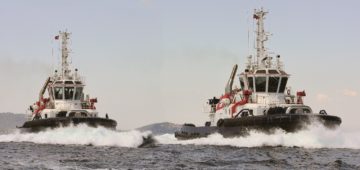



Comments
Sorry, comments are closed for this item